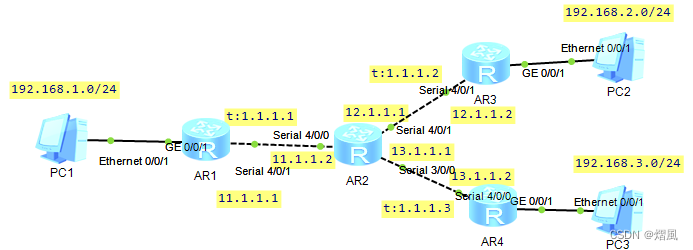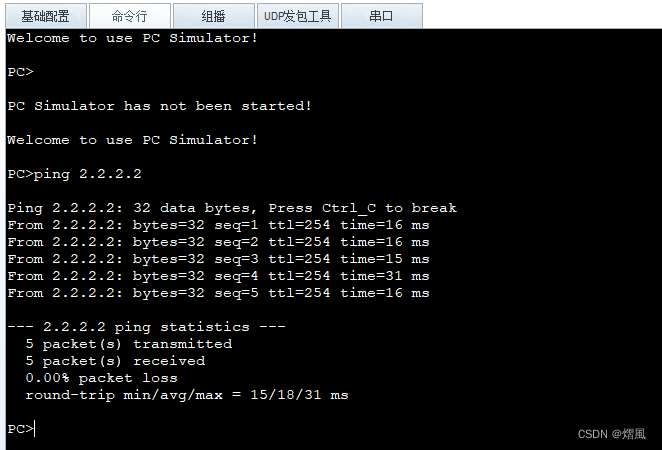当前位置:网站首页>Hcip section 1: network type learning
Hcip section 1: network type learning
2022-07-21 23:14:00 【Shining wind】
One 、 Network type :
Point to point
BMA: Broadcast multiple access – In a MA There are also broadcasts in the network ( flooding ) Mechanism
NBMA: Non broadcast multiple access — In a MA In the network , No flooding mechanism
MA: Multiple access In a network segment , There is no limit to the number of nodes
Two 、 Encapsulation technology of data link layer
【1】 Point to point – In a network segment , The number of nodes is physically and logically limited to 2 individual ;
Two layer packaging technology based on point-to-point work , There is no layer 2 unicast address , such as MAC Address
HDLC Cisco Encapsulation technology used by default ; Each manufacturer owns this technology
PPP Not Cisco The default encapsulation technology used by the serial interface ; Public technology stay HDLC On this basis, some functions are further added ;
PAP Pass user name and password in clear text
CHAP Ciphertext
GRE Generic routing encapsulation -- A simple VPN technology -- It belongs to the type of point-to-point network
VPN Virtual private network --- Let the two networks communicate directly through the intermediate network , Logically, a new point-to-point direct link is established between the two networks ;
BMA – Broadcast multiple access In a MA There are also broadcasts in the network segment 、 Flooding function ;
Ethernet Shared network
In a physical link, a large number of frequency radio waves are used to transmit data at the same time , Play the role of bandwidth superposition ;
NBMA Non broadcast multiple access --- Frame relay /MGRE
Between multiple networks, you need to pass VPN To build a whole network , If you use point-to-point GRE;tunnel And the number of network segments will increase exponentially , The routing table will become larger , All nodes are required to be fixed public IP Address ;
MGRE Can solve these problems :
MGRE— Multipoint GRE -- Also known as DSVPN The automatic intelligent VPN= MGRE+IPSEC
ordinary GRE Is a point-to-point network type ; If multiple nodes are used as normal GRE Connect , A large number of network segments and routing information will be configured , And all nodes are fixed IP Address ;
The experiment is as follows

The experiment purpose
1.R2 by ISP, Can only be configured on it IP Address
2.R1-R2 Between for HDLC encapsulation
3.R2-R3 Between for ppp encapsulation ,pap authentication ,r2 Main certifier
4.R2-R4 Between for PPP encapsulation ,chap authentication ,R2 Main certifier
5.R1、R4、R3 structure MGRE Environmental Science , only R1IP Fixed address
6. Intranet usage RIP Get route , all pc Can access each other , And accessible R2 The loopback of .
Investigate knowledge points :
hdlc encapsulation ppp encapsulation pap authentication chap authentication To configure MGRE Environmental Science rip dynamic
Experimental thinking
1 Divide network segments , configure port ip, Loopback routing Public network critical route configuration default route
2. To configure hdlc ppp encapsulation Conduct network segment pap chap authentication
3 build MGRE Environmental Science
4 Conduct rip Dynamic routing protocol configuration
Experimental process
Partial routing ip as follows
r1 And r2 route ip


2. To configure hdlc ppp encapsulation Conduct network segment pap chap authentication




3 build MGRE Environmental Science

、
The build result test is as follows ( Because of the use of rip, So turn off horizontal segmentation )
[r1-Tunnel0/0/0]undo rip split-horizon 

4 Conduct rip Dynamic routing protocol configuration



Route result acquisition
r1 as follows

r2 Without deleting the horizontal partition, it is divided as follows

Delete the horizontal division as follows

equipment ping through


Access loopback

边栏推荐
猜你喜欢
随机推荐
GRE,MGRE
Irregular area of OSPF
Comparison between VoIP soft switch and line selection
“==“与equals的区别
Parameters of function
TCP three handshakes and four disconnects
Hcip day 2
实验2-白盒测试-软件质量保障与测试
RIP综合实验
OK the telephone system rules configured in the outbound call center
HCIA
Hcip day 5
第五天,ospf数据包
D3D function description
HCIP 第一天
OSPF -- Open Shortest Path First Protocol
Hcip OSPF comprehensive experiment
C implementation of extended tree of binary tree
Properties文件的读取和写入
Excel文件的解析









